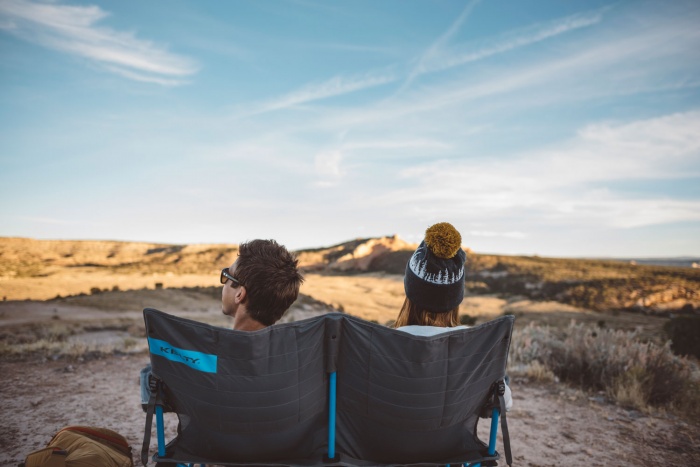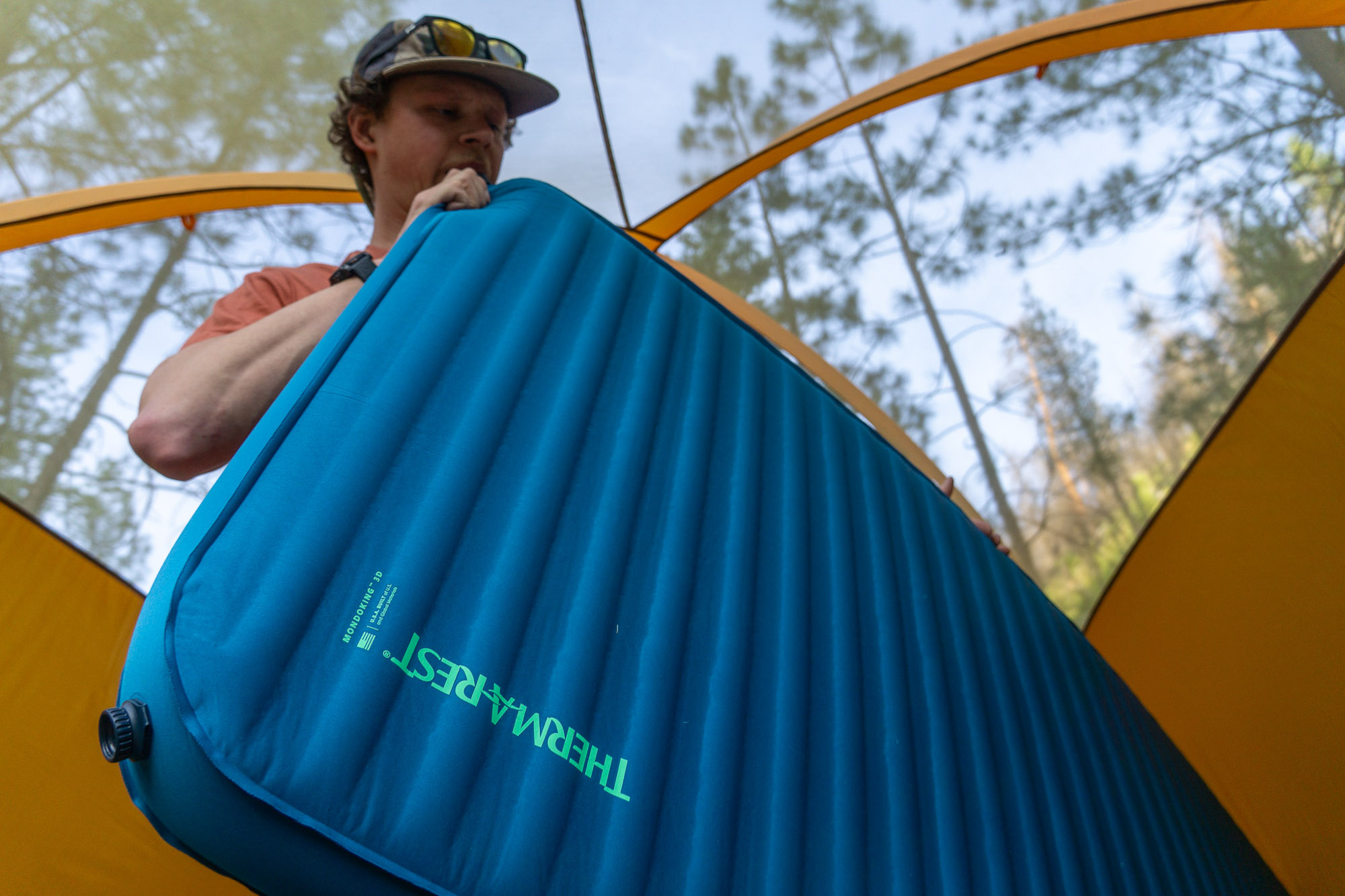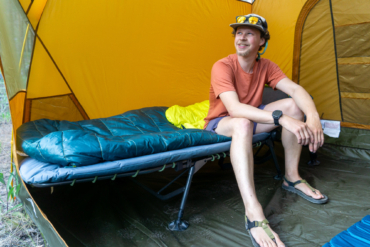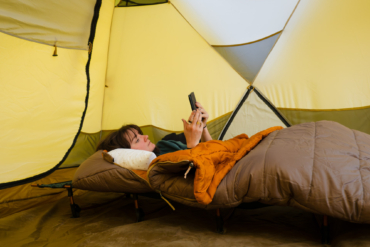Head into the mountains or forests and pitch your tent in an ideal location. These tips will help you find that perfect camp spot.

Sometimes it’s the destination, not the journey. Camping is one of those idiom rule-breakers. “This viewless plot at the bottom of a hole will suffice,” said no camper ever.
No, we are a tribe in constant pursuit of the next OS screensaver — that lakeside shimmer, a skyline pierced with granite peaks, ready to sponge up the last of the evening light.
In the market for some backcountry real estate? We’ve outlined some basic camping principles (and etiquette) to help make your next camp the best yet.
Before You Go
The hunt for a camp starts at home. Some hot spots, like the John Muir Trail, have limited quotas and require landing a (highly competitive) lottery permit. Others have six-month advance registration. There can also be rules imposed on fire, group sizes, and pets.
Know before you go; research the land management agency regulations, restrictions, and permit requirements.
Pro-tip: If you are backpacking, spread the map out at home and look for “destination” camp spots. A spectacular view, that trout-choked lake, a Tolkien-like forest, or interesting history — prime destinations can keep you motivated at the end of a long day and make your trip one to remember.

Established Campsites
Often the best campsite is the one that already exists. The kinks are worked out. The problems are solved. The fire pit is dug. An outhouse might even be available. And often these spots are front-row to some spectacular views.
You can use rocks or chopped wood for seats and benches. Or, if you’re camping car side, enhance your experience with a comfy camp chair like Kelty’s Mesh Low-Love Chair.

Use these sites if they exist, but know they could have downsides, including noisy neighbors, sanitary issues, and habituated critters who might unexpectedly swing by to see what’s for dinner.
Pro-tip: Campers snatch the best-established campsites quick. To get your pick of the litter, consider hiking in on a Thursday before the prime spots disappear.
Backcountry Campsite
Roughing it? Choice spots still exist deep in the woods. But it will take a little more effort (and restraint) on your part. Here are some things to consider before plopping the tent down.

Find a clear spot. Look for a plot on flat rock, sand, or bare ground. Don’t pitch the tent over foliage, cut back branches or remove stones. If that won’t work, move on.
Find a flat spot, preferably with slight convex pitch to keep you warm and dry. A depression is a natural conduit for water during storms and cool air at night. Don’t dig trenches around your tent or camp. Look for natural drainage.
Similarly, gravity is a strong force. A slope will eventually spill you and your tent mate into the corner of the tent. Save yourself the trouble — look for a flat spot.
Don’t be a space hog. Use a tent that fits your needs and takes up only the real estate you need. Kelty’s Horizon 2 is a lightweight modified dome ideal for two people in the backcountry.
Camp at least 200 feet away from water. A good camp spot will always have nearby water. But give it some clearance for animals to drink from and prevent human contamination. And of course, bugs — they are drawn to moist environments and can be a real “buzz” kill.
Trees provide shade, buffer the wind, insulate heat from the day, and trap radiant heat at night. Rocks can also serve as a wind buffer.
But beware of bedding down under a single, tall tree, which can become a lightning rod. Better to find a small stand of trees for protection.
Don’t “improve” it. If a place still exists in a natural state, leave it that way for others to enjoy. Cairns, benches, and fire rings leave evidence of previous visitors. Remember to leave no trace.

Know the rules around fire. Particularly in late summer, many places will ask that you use fire pans or restrict fires altogether. So if you’ve found a prime spot that’s missing the stone hearth, avoid the temptation to build new fire-pits.
Give your neighbors space. Looking to get away from it all? So is everyone else. Camp spots are like urinals, people don’t want to saddle up right next to one another if other, more distant spots are available.
Pack it in / pack it out. In the same vein of respect, everybody wants to experience a camp that appears fresh, untapped. In particular, nobody wants to see your toilet paper.
Dig a six-inch-deep cat hole and bury your deed. Kelty’s Deuce of Spades camp trowel is light enough to carry with you, so no excuses. Toilet paper can be buried in moist soil, which supports rapid decomposition. But it’s better to carry it out in dry environments.
Consider the direction of the wind. Wind can blow weather sideways right into your tent. To prevent wrestling with the tent flap, face the back of the tent into the wind, protecting you as you enter and exit the tent.
Air flow. Keep in mind that cool air sinks and warm air rises. A higher camp will be warmer at night, and expose your camp to a little more breeze to keep bugs down and move condensation off tents walls.
Like morning sun? Face the door the east. That same morning sun can expedite breaking camp the next morning by drying out the tent early on.
Safety. Eyes up. Look for deadfall, or widow makers, hanging in trees. It’s only a matter of time before they fall. Debris at the bottom of a gully? That’s a good spot to avoid too. And stay out of canyon bottoms that could flash flood after a storm.
As campers, we are stewards of our public lands. Practice low impact. A great camp finds the sweet spot of solitude, safety, and those jaw-dropping views.
– This post is sponsored by Kelty. Follow Kelty on Facebook, Instagram & Twitter.






